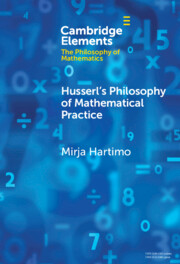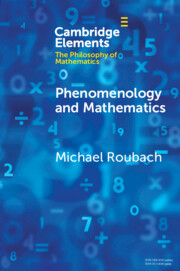Refine search
Actions for selected content:
19 results
Chapter 7 - Time, Cause, and Particularity
-
- Book:
- The Neural Structure of Consciousness
- Published online:
- 27 July 2025
- Print publication:
- 18 September 2025, pp 202-231
-
- Chapter
- Export citation
Chapter 6 - Praxis Epistemology III
-
- Book:
- Vico and the Maker's Knowledge Tradition
- Published online:
- 27 June 2025
- Print publication:
- 17 July 2025, pp 185-221
-
- Chapter
- Export citation
21 - Interaffectivity Disturbances in Narcissistic Personality Disorder
- from Part V - Perspectives on Borderline and Narcissistic Personality
-
-
- Book:
- Conceptualizing Personality Disorder
- Published online:
- 25 June 2025
- Print publication:
- 10 July 2025, pp 373-385
-
- Chapter
- Export citation

Husserl's Philosophy of Mathematical Practice
-
- Published online:
- 04 December 2024
- Print publication:
- 16 January 2025
-
- Element
- Export citation

Phenomenology and Mathematics
-
- Published online:
- 27 November 2023
- Print publication:
- 21 December 2023
-
- Element
- Export citation
6 - Phenomenology
- from Part I - Intellectual Sources and Disciplinary Engagements
-
-
- Book:
- The Cambridge Handbook for the Anthropology of Ethics
- Published online:
- 11 May 2023
- Print publication:
- 25 May 2023, pp 155-176
-
- Chapter
- Export citation
18 - Humanistic Psychology
- from Part II - Systems of Psychology
-
- Book:
- History and Systems of Psychology
- Published online:
- 04 November 2022
- Print publication:
- 17 November 2022, pp 390-418
-
- Chapter
- Export citation
Chapter 5 - Derrida and Différance
-
- Book:
- Judgement and Sense in Modern French Philosophy
- Published online:
- 09 June 2022
- Print publication:
- 23 June 2022, pp 148-177
-
- Chapter
- Export citation
Excursus IV - Transcendental Reflection: Time Synthesis and the Role of the “I”
- from Part II - Philosophical Reflections
-
- Book:
- The Divine Vision of Dante's Paradiso
- Published online:
- 26 August 2021
- Print publication:
- 19 August 2021, pp 227-243
-
- Chapter
- Export citation
13 - Gadamer’s Relation to Heidegger and to Phenomenology
-
-
- Book:
- The Cambridge Companion to Gadamer
- Published online:
- 29 July 2021
- Print publication:
- 12 August 2021, pp 334-354
-
- Chapter
- Export citation
Chapter 10 - Cassirer’s Phenomenological Affinities
- from Part III - Cassirer’s Philosophical Method
-
-
- Book:
- Interpreting Cassirer
- Published online:
- 17 April 2021
- Print publication:
- 01 April 2021, pp 193-213
-
- Chapter
- Export citation
Chapter 11 - Cassirer’s Place in Today’s Philosophical Landscape
- from Part III - Cassirer’s Philosophical Method
-
-
- Book:
- Interpreting Cassirer
- Published online:
- 17 April 2021
- Print publication:
- 01 April 2021, pp 214-236
-
- Chapter
- Export citation
The Other in Deleuze and Husserl
-
- Journal:
- Dialogue: Canadian Philosophical Review / Revue canadienne de philosophie / Volume 60 / Issue 1 / April 2021
- Published online by Cambridge University Press:
- 03 December 2020, pp. 93-120
-
- Article
-
- You have access
- HTML
- Export citation
11 - Levels of Embodiment
- from Part III - Borderline Personality and Eating Disorders
-
-
- Book:
- Time and Body
- Published online:
- 30 October 2020
- Print publication:
- 12 November 2020, pp 234-255
-
- Chapter
- Export citation
12 - Phenomenology of Corporeality (and Spatiality) in Anorexia Nervosa with a Reference to the Problem of Its Temporality
- from Part III - Borderline Personality and Eating Disorders
-
-
- Book:
- Time and Body
- Published online:
- 30 October 2020
- Print publication:
- 12 November 2020, pp 263-281
-
- Chapter
- Export citation
12 - Commentary on Gallagher “Body Self-Awareness: Multiple Levels or Dynamical Gestalt?”
- from Section 4
-
-
- Book:
- Levels of Analysis in Psychopathology
- Published online:
- 02 April 2020
- Print publication:
- 02 April 2020, pp 160-168
-
- Chapter
- Export citation
Some reflections on Husserlian intentionality, intentionalism, and non-propositional contents
-
- Journal:
- Canadian Journal of Philosophy / Volume 47 / Issue 4 / 2017
- Published online by Cambridge University Press:
- 01 January 2020, pp. 499-517
-
- Article
- Export citation
Husserl’s Project of Ultimate Elucidation and the Principle of All Principles
-
- Journal:
- Canadian Journal of Philosophy / Volume 50 / Issue 3 / April 2020
- Published online by Cambridge University Press:
- 08 November 2019, pp. 285-296
-
- Article
-
- You have access
- Open access
- HTML
- Export citation
Chapter 5 - A Second Philosophy of logic
- from Part I - The Main Positions
-
-
- Book:
- The Metaphysics of Logic
- Published online:
- 05 October 2014
- Print publication:
- 16 October 2014, pp 93-108
-
- Chapter
- Export citation
